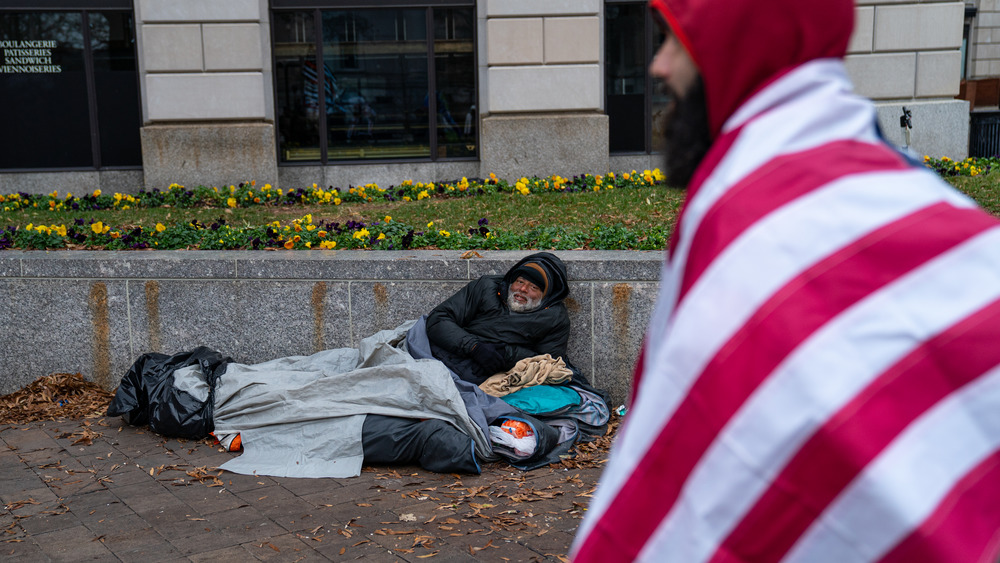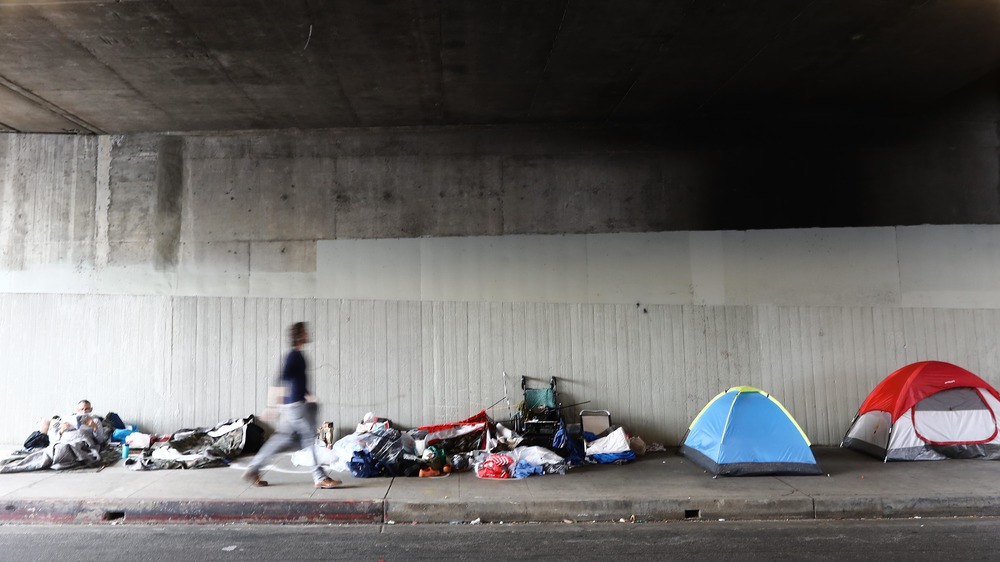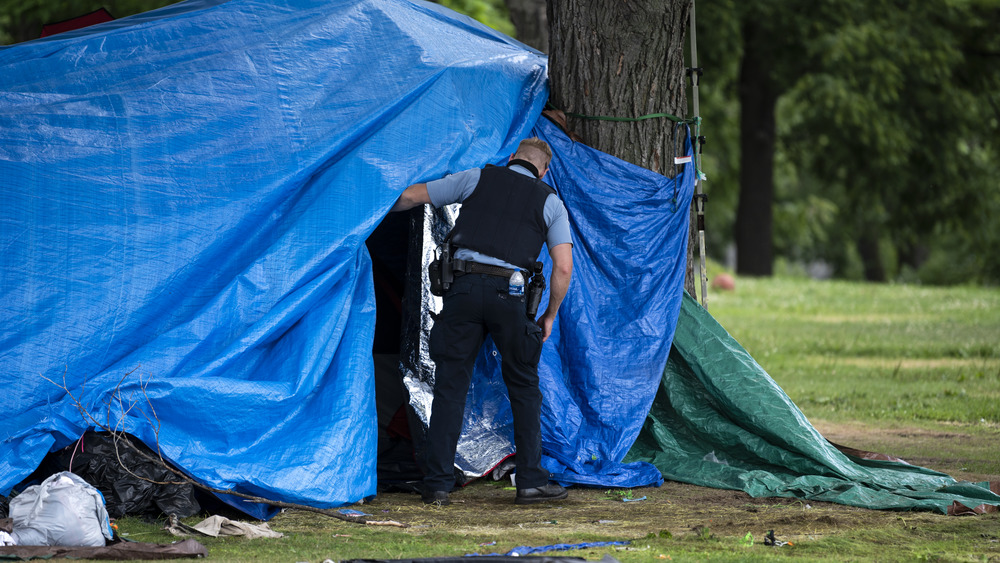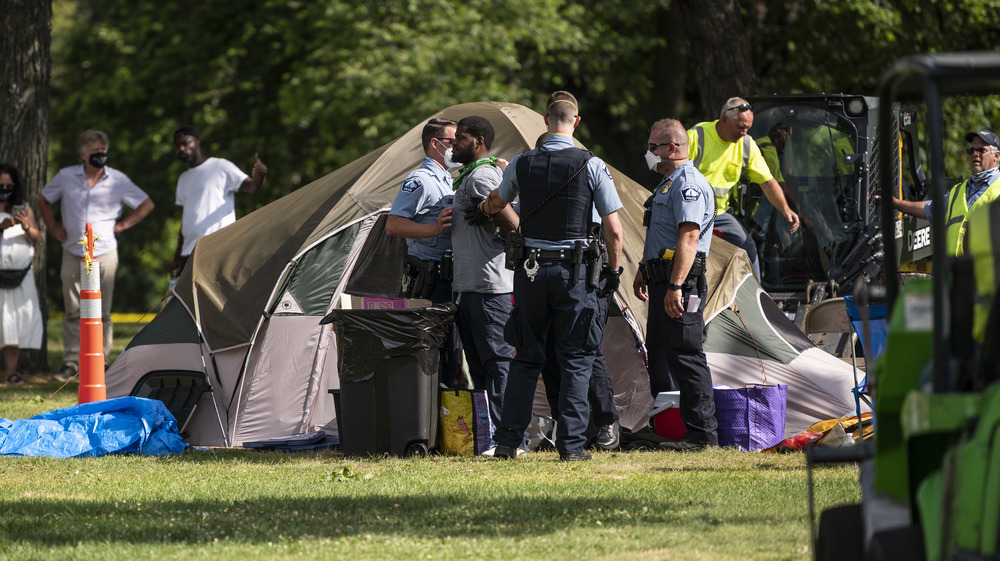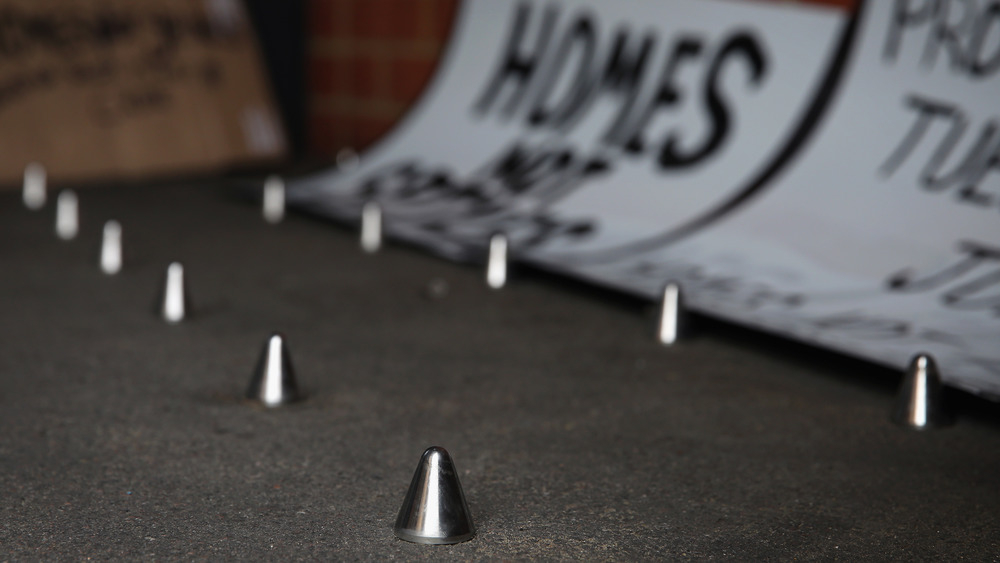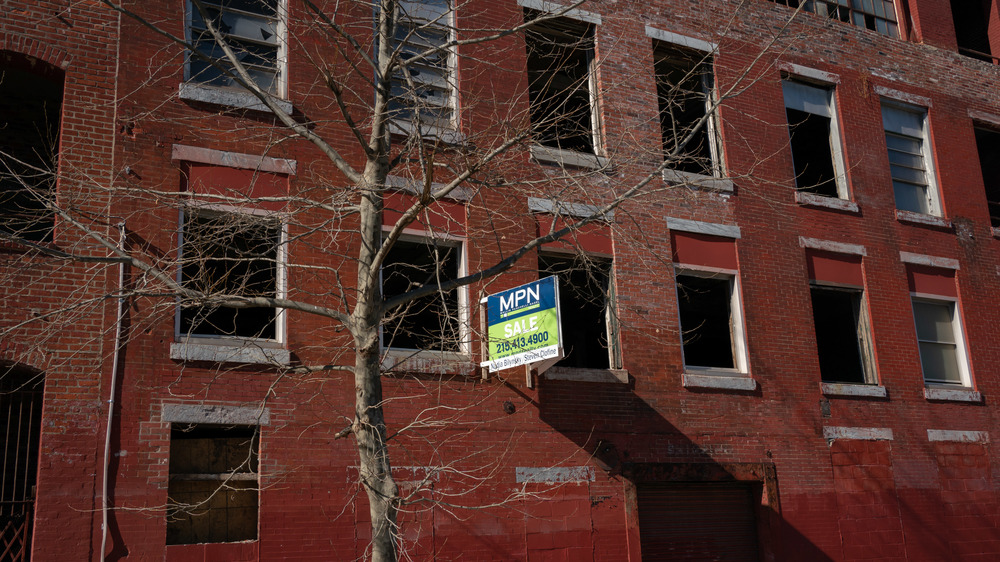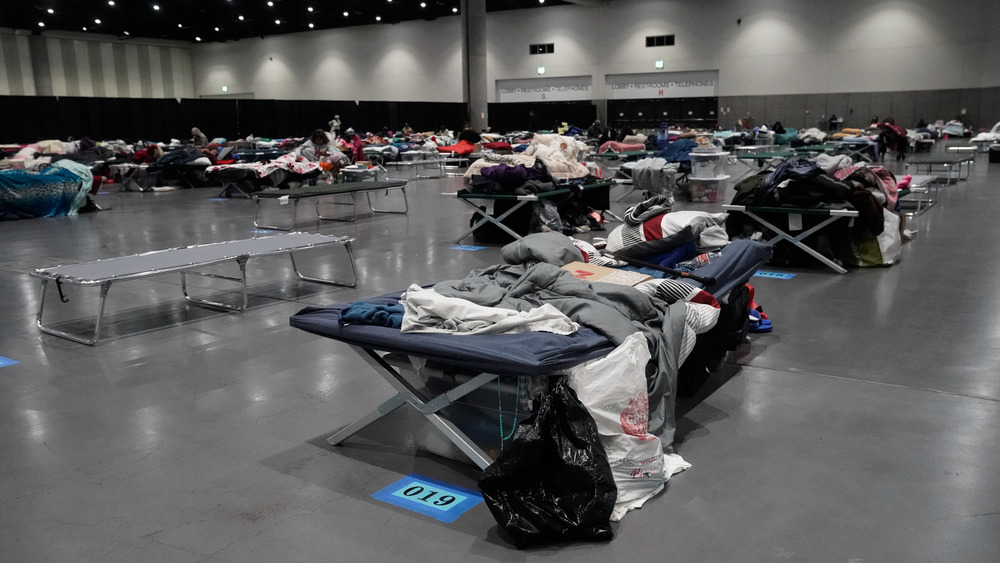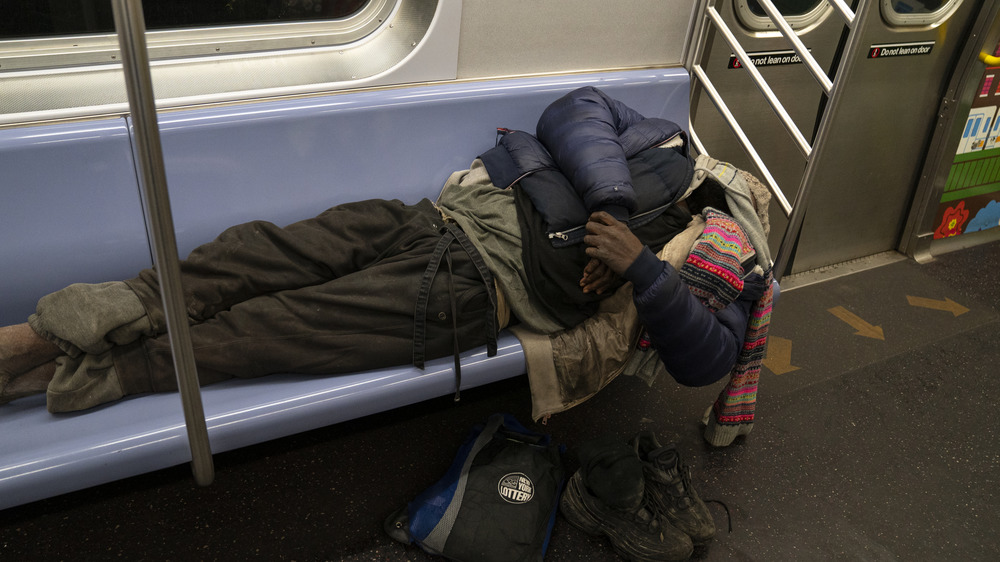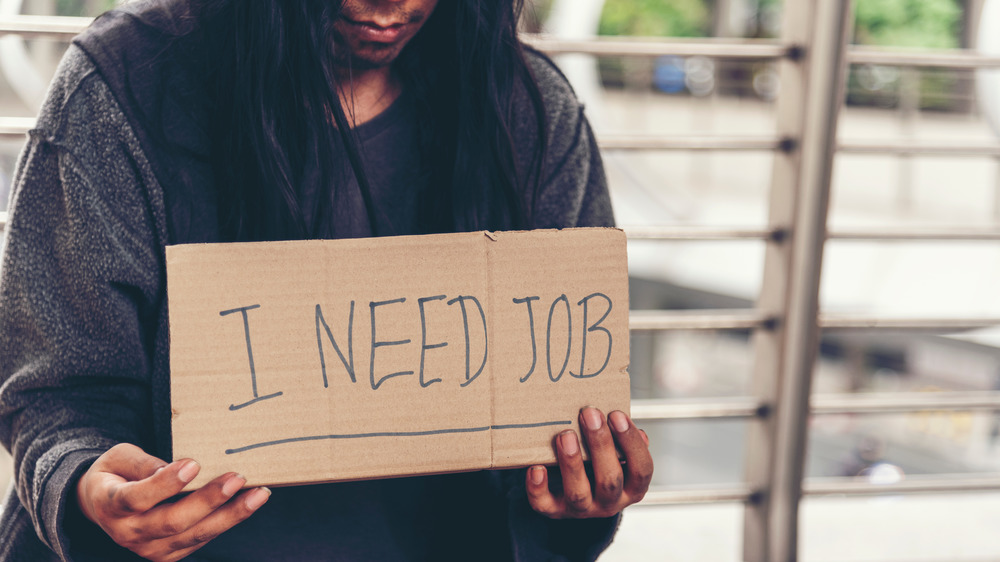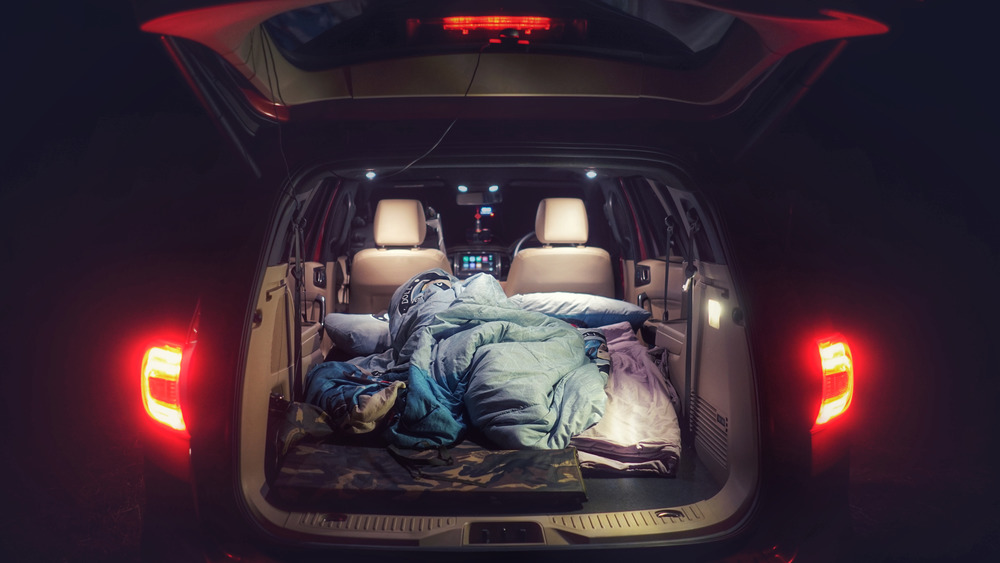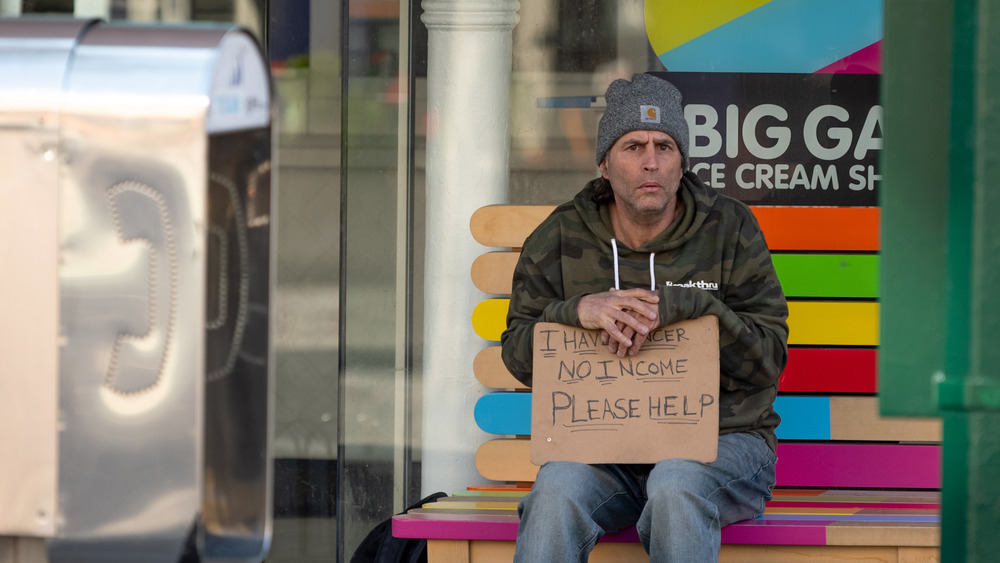The Messed Up Truth About Homelessness In America
Most people's lives seem hard at one point or another. The problems build up, a necessary piece of technology moves out of our financial reach, unforeseen medical expenses catch us off guard, you name it. Life can be a serious pain in the behind sometimes. But as long as we have a roof over our heads, we'll usually come out the other end of our troubles with little more than a bum attitude and a slightly lower credit score. Without that home, however, what we may have thought were problems become laughable inconveniences compared to the issues faced by homeless people.
Homelessness takes a person and feeds their life's issues through a grinder that multiplies everything by a random exponent, then spits said person out into the street and not-so-politely tells them to survive by their wits — or die. It's truly a horrid thing. The National Alliance to End Homelessness estimated that the United States had over 560,000 homeless people in 2019, and our system really isn't designed to make life easy for that many unfortunate folks. We're frankly bad at homelessness and, because we are so poorly equipped to help, a problem that should've been eradicated by now thrives in the worst of ways.
Tent cities pop up for a reason
When homeless folks in the United States either can't or won't (often for valid reasons) go to a shelter or crash on a friend's couch, assuming they even have the option, they don't just stop existing. There are some parts of society that might think they should, but that's simply not how life works. These people still need a place to lay their heads at night. And where one goes, others are sure to follow.
Tent cities, as The Atlantic points out, tend to crop up in areas where low-income housing and other such programs can't keep up with the number of people who need those services, which is often in major cities. The tents and other makeshift dwellings found in these quasi-legal and densely packed areas, usually located in rundown areas of town or other low-trafficked places, contain the last remains of these less-fortunate folks' lives. They also contribute to a level of community, which in turn provides a bit of safety, since individuals there now have a few friendly people to watch their backs. Strength in numbers is a big deal, especially when you don't have a home.
Other creative situations, such as the Las Vegas "Mole People" living below the city in sewer tunnels (via Insider), have popped up to serve the same purpose. And where these living situations are still dangerous, especially during the COVID-19 pandemic, it sure beats sleeping in a storm drain, vulnerable and alone.
Police might confiscate homeless people's tents and survival gear
As if being homeless isn't hard enough on these folks when they're left alone, there are plenty of local, county, and state authorities who go out of their way to make things even more difficult. In 2019 in Los Angeles, according to the Los Angeles Times, lawsuits were brought against the city after officers repeatedly seized tents and other property from homeless encampments during a citywide "clean up" effort. Curbed notes that one of these lawsuits targets a city ordinance that only allows homeless people to carry belongings that, in total, can fit inside of a 60-gallon container.
California isn't the only locale to conduct sweeps and seizures of homeless encampments, which many see as an attack against an already less-fortunate group of people, either. According to PEW, these seizures span clear across the country, from Los Angeles to Texas, to Minnesota, and further, even though the Centers for Disease Control advocated against such moves to prevent the spread of COVID-19.
And what's the primary reason these communities confiscate the last few possessions, often gear necessary for survival, from people who've already lost nearly everything? Well, duh, have you seen how ugly a tent looks in the middle of town? Yes, there are people out there who find homeless people to be enough of an "eyesore" that they're willing to take away their shelter and give death one less hurdle as it encroaches upon their lives.
Being homeless is illegal in many places
Now, being homeless isn't technically illegal on its own. If you lost your house but had a friend's couch to sleep on or the available cash to bunk up in a motel room, you'd probably be fine. However, that's a relatively lavish brand of homelessness that a lot of street-bound folks don't have the luxury of experiencing. For many who are housing-deprived, their everyday lives are outlawed in one way or another.
Cities have been passing more and more laws directed at reducing the impact of homelessness on their towns, but those laws rarely solve any problems. Instead, many of the laws seem to be designed in a way that makes life difficult for the homeless and drives them to other areas. According to Vice, more than 187 cities have passed "anti-homeless" laws in the past few years. Some of the laws in question even make it illegal to sleep in your vehicle.
Other laws target loitering and trespassing, making it difficult for weary homeless folks who are moving on foot to rest. They're effectively barred from finding a place suitable for a moment of relaxation or to find safety from hostile weather conditions. The Coalition of Human Needs points out that some places have also made it illegal to sleep outside, while others, according to ABC News, outlaw panhandling. The publication also found that fines and arrests for these crimes disproportionately affected Black people.
Hostile architecture is a silent attack on the homeless
After a while, it looks almost as if the homeless in the United States are being attacked from every side. Their belongings get seized, they're looked down upon by average pedestrians, and they have a really hard time finding a place to sleep or even sit down without getting fined or arrested. But some cities and private businesses have decided to take things a step further. If laws and ordinances won't keep these pesky houseless human-freaking-beings away from their fancy storefronts and out of their parks, then maybe spikes will.
Hostile architecture, which Street Roots explains is also called "defensive architecture," takes many forms and has become an unfortunate trend in recent years. Interesting Engineering showcases several different types, such as ugly bolts meant to keep people from sitting on company steps and triangular spikes intended to discourage loitering near a public planter, to name only a couple. Other examples include park benches with internal armrests that keep people from lying down to sadistic pigeon pins on staircases and giant rocks taking up portions of unused turf.
Along with this trend's harm to the homeless community, it's had an effect on everyday pedestrians as well. According to Architectural Digest, these devices make public spaces hostile and uninviting to everybody. Sometimes being a jerk has unintended consequences.
The number of vacant homes far surpasses the homeless population
To put it bluntly, there are enough vacant homes in the United States to house every homeless person in the country several times over. Let's look at the numbers. According to the National Alliance to End Homelessness, there were almost 580,000 homeless people living in the United States in 2020. That's a lot, to be sure, but it's nothing compared to vacant housing. The United States Census Bureau estimated that there were over 15 million vacant residences in the country during the fourth quarter of 2020. That's more than 25 houses for each homeless individual, but they're still sitting empty because poor folks don't have the cash to live between four walls.
Now, some people see an easy solution in these numbers: fill these vacant quarters with people who don't have a home. It would end the whole homeless thing and use up less than 1/25 of the vacant homes out there. But others argue that someone paid good money for those empty homes and they deserve to be compensated. Cool. It's like we have a beginning and end but we're missing a middle step in this process that would link the two together.
If there was only some inflated area of the country's budget that could get deflated for some extra cash. Perhaps that could be found somewhere in a nation that, according to Statista, has the highest military budget in the world at over $700 billion dollars.
Homeless shelters aren't always a good option
Plenty of people believe that if someone is homeless, they always have the option to stay at a homeless shelter to keep warm at night. They believe this probably because they don't know much about homeless shelters. Even if every homeless shelter was accessible and had rules that worked for all, there still wouldn't be enough shelters for every house-deprived person in the country. Some states, as the National Alliance to End Homelessness points out, have enough capacity to house their estimated homeless population, while other states might not have enough shelter beds for even half of the homeless people there. However, space isn't the sole issue here.
As Vice points out, many shelters have curfews that prevent anybody who works nights from being able to stay. Other shelters might separate men and women or families, while some only accept those who are escaping violent situations. Some shelters may also be perceived to be unsafe and unstable, both by homeless people and shelter staff. Then there are the shelters that are proud to be humanitarian — as long as your lifestyle fits their beliefs. Some shelters will outright refuse to help people who are LGBTQ+. The Salvation Army, in particular, has come under fire for its alleged past full of anti-LGBTQ+ discrimination, says Vox.
The real reasons people become homeless
There are plenty of misconceptions about why people go without homes. The belief that these unfortunate folks have made their own beds, so to speak, through drug and alcohol addiction or just plain laziness is both common and wrong. Sure, some homeless people were driven onto the streets because of addiction issues, but as the American Psychiatric Association points out, addiction is a legitimate disorder and should be treated as such.
The vast majority of homelessness is caused by factors that have nothing to do with laziness or addiction. Homeless Hub mentions quite a few of the primary causes of this houseless condition, including things like fleeing from domestic violence, house fires, and job loss. The high cost of medical treatment can drive people into homeless as they struggle to survive life-threatening conditions and crushing debt. The rising cost of rent and stagnant pay in many areas leads some to choose between food and rent. According to The New York Times, untreated mental health issues can also lead to a lack of stability that lands a person on the street.
If the cards are wrong, anyone can find themselves in a situation leading to homelessness. There is a vast portion of the United States population that's only one or two missed paychecks away from eviction and, unfortunately, Black people are more likely to experience this harsh reality, according to the National Law Center On Homelessness and Poverty.
Being homeless makes getting a job and finding a place to live more difficult
Since homelessness means not having a place to live and that usually happens by not having or being able to get a job that pays enough to survive, being homeless is a real catch-22. You need a home to get a job. But, you need a job to afford a home. Some homeless people can and do work jobs just like the homed, but getting that job while they're homeless can be an exceedingly tough struggle.
As The Human Impact points out, most job applications require that you have an address. That gives a homeless person two choices: leave the field blank and have a potentially zero chance of landing the position or lie and falsify their application. They might also have significant gaps in their resume that make it tough for potential employers to consider hiring them.
But the address isn't the only issue. When you're poor and homeless, it's difficult to come up with the type of nice clothes you'd typically wear to work or even an interview. It's also difficult to keep up one's personal hygiene since showers and laundry facilities are few and far between, as the International Journal of Environmental Research and Public Health reports. Even finding a sink can be difficult since private businesses might require one to be a customer before using their facilities.
There has been increase in working homeless people
Even though it's more difficult for homeless folks to get jobs, it doesn't mean that homeless people with jobs aren't out there. According to The New York Times, there's been a steady increase in "working poor" for years, which has naturally led to more and more people trying to keep regular jobs while experiencing homelessness. This increase has little to do with not having jobs, generally speaking, and more to do with the types of jobs available for people in these situations.
The working homeless issue is most notable in urban areas of California, but, as The Washington Post points out, the situation isn't unique to just one state. The rising cost of living in these places is difficult to afford on the low-paying salaries that many jobs in these areas offer, so workers are forced to make decisions they never thought they would while holding down a full-time job. Namely, what possessions they can shove into the backs of their cars while still having enough room to sleep.
Having a vehicle can give some people a bit of a leg up, however. Regardless of how much homelessness sucks, a vehicle can score a job at one of many rideshare or food delivery companies that have become such a necessary part of our daily lives. Without one, the job options are limited. leaving many with no hopes of getting back on their feet.
The economy has a surprising correlation with homelessness
The economy definitely affects the rate of homelessness, and it only seems natural to assume that when the economy tanks, homelessness increases. In some ways that's true, but homelessness actually increases more when the economy booms. Seems counterintuitive, right? Not if you really think about it.
According to McKinsey & Company, the rise in homelessness pretty clearly follows the line of our economic booms, and it does so because of how the wealthy tend to spend their money when the money is good. A thriving economy often means there's more money to spend on luxury housing — gentrification anyone? — which in turn drives the rent and housing prices up. People then get pushed out of homes they could previously afford.
In contrast to the economy's effect on homelessness, higher homeless populations hit our country's pockets too. As the American Security Project notes, homelessness is expensive in a society. Taking care of a population that would otherwise do okay on their own, at least if the right resources were available to them, costs billions of dollars each year through publicly-funded services. It's almost as if we should take care of the problem at its root instead of trying to clean up after the mess is made. Crazy.
Homeless people face seriously tough choices
Being homeless comes with difficult choices. When money is short supply, you have to rate the necessity of everything you spend it on. Food, for instance, becomes more important than shelter because, without food, you'll likely die long before the weather gets to you. As the Journal of Health and Social Behavior details, food security differs for each homeless person based on their available resources. Sometimes a person might be forced to dig through dumpsters in search of a meal, while other times there are soup kitchens or pantries available. It varies, but limits are limits nonetheless.
This means medical expenses that would usually prolong life and grant a higher life-satisfaction get pushed off while the homeless solve problems that threaten to kill them more immediately. Five years, ten years, even a month is too far off to bother worrying about when threats like dehydration, starvation, and the frigid cold are looming over you.
According to the Homelessness, Health, and Human Needs, even when medical care is given, it's difficult for homeless people to maintain. Bedrest, for instance, is nearly impossible when you don't have a bed. Without free clinics, finding medication is difficult, while mental health care is basically a "nope" from the get-go. Throw clothing, pets, hygiene products, camping gear, and children into the mix, and being homeless quickly becomes too difficult for even the most astute to handle.
